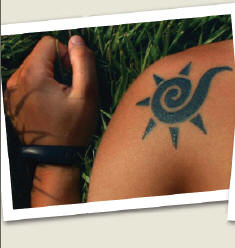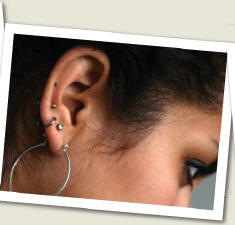Family: Majors and Minors
 |
 |
“Mom, when can I get my ears pierced?” my 12-year-old son asked.
“Mom, I want a tattoo,” my 17-year-old daughter declared.
Family night is a real learning experience in our household. One of my children chooses the restaurant we will dine in (I rarely create edible and/or tasty food), and my other one chooses our entertainment for the evening—they trade choices each weekend. What I learn during our meal continually amazes me, yet validates my sense that children want parents to care about what the children care about in their developing world.
Curfews, slouchy oversized denims, MySpace, gang affiliation, low-rise-midriff-baring clothing, mobile/cellular phones, afros, skater gear… A lot to digest for a parent attempting to remain somewhat knowledgeable of the social habits that are important to her children.
I have come to believe that King Solomon’s words are eternal: “There is nothing new under the sun, all that has been, will be again…” Our parents suffered the same angst about the interests and futures of their adolescents that we do as we struggle to manage our parental responsibility with love and morality. It is comforting for me to realize that the stages of emerging adolescent independence are fairly predictable, and as parents we can look for two common signposts on the path of a child’s pursuit of personal identity: 1) The child is consumed by what the child wants to do and finds his or her desires fully justifiable, and 2) The parent is disturbed by what the child wants to do, believing it to be a reflection of the parent’s skills as a responsible custodian.

Remembering that my feelings are normal, but misguided, helps me get over myself and what I perceive others may think of my parenting decisions. Then I am better able to concentrate on morally responsible parenting. For me, it has come down to this: Majors and Minors.
When my child approaches me with a request for a “personal alteration,” I first evaluate it under the scope of major (implications) and minor (implications) of experimentation using the three “I”s: Is it Illegal? Is it Immoral? Is it Immoderate?
| The stages of emerging adolescent independence are fairly predictable, and as parents we can look for common signposts on the path of a child’s pursuit of personal identity. |
First, Illegal: My child’s desire for a piercing is not against federal or state law; however, it may be against school rules for males to have a visible piercing, thereby rendering it “illegal” in his context. Next, would his proposed piercing be Immoral—violating life or liberty for another human being by trespassing right or wrong behaviors? Finally, is the request Immoderate—lacking in balance of energy spent toward the behavior, financial expense to maintain the behavior, or rehabilitative expense to keep the behavior in check?
Once I pass my child’s proposition through the three “I”s, it is time to see how it passes through my filters of importance. This process allows me both to check my own biases and preferences, as well as to provide my children clear, meaningful, and morally sound guidelines for their conduct while clarifying for them my expectations.
It is a lot like a job description or promotion criteria— we need to know what our employer expects so that we can perform at a level that is meaningful and choice-driven as an employee. When I know what my superordinates in the workplace expect, I am better able to make positive and useful contributions toward the shared goals of the organization. Most people have experienced the frustration of an ever-changing, ill-defined set of expectations for the employee—it is disheartening and debilitating to human productivity and creativity.
In the same way, children need reliable, definable, and structured guidelines for behavior in their development. Some parents have difficulty maintaining rigid cause-and-effect consequences for their children because they want their children to either 1) like them, or 2) not suffer. Neither of those sentiments is a responsible position for a parent to take.
Children test us to know they are safe. Think of it this way: When you get on a roller coaster, what is the first thing you do? You fasten the safety harness, then vigorously jiggle it to ensure that it has you reliably fastened! Children “jiggle” our guidelines and rules to ensure that they will be secure for the roller coaster ride that is adolescence. It is easy to succumb to their whinings, complainings, and “I hate you’s,” but the bottom line is, as a parent, you are their authoritative sentry.
On the other hand, if my child’s request is not illegal, immoral, or immoderate, then I grow as an individual attempting to understand an ever-changing world. The meanings of specific haircuts, denim styles/lengths, piercings, etc. and what they symbolized in my adolescence have changed, and so should my awareness. I don’t have to agree with it or like it, but I need to be informed in order to make meaningful and rational decisions for my children’s best interests in their ever-evolving world. •
 Dr. Rose Huff lives and works as an educational psychologist in Southern California.
Dr. Rose Huff lives and works as an educational psychologist in Southern California.
Author: Rose Huff
